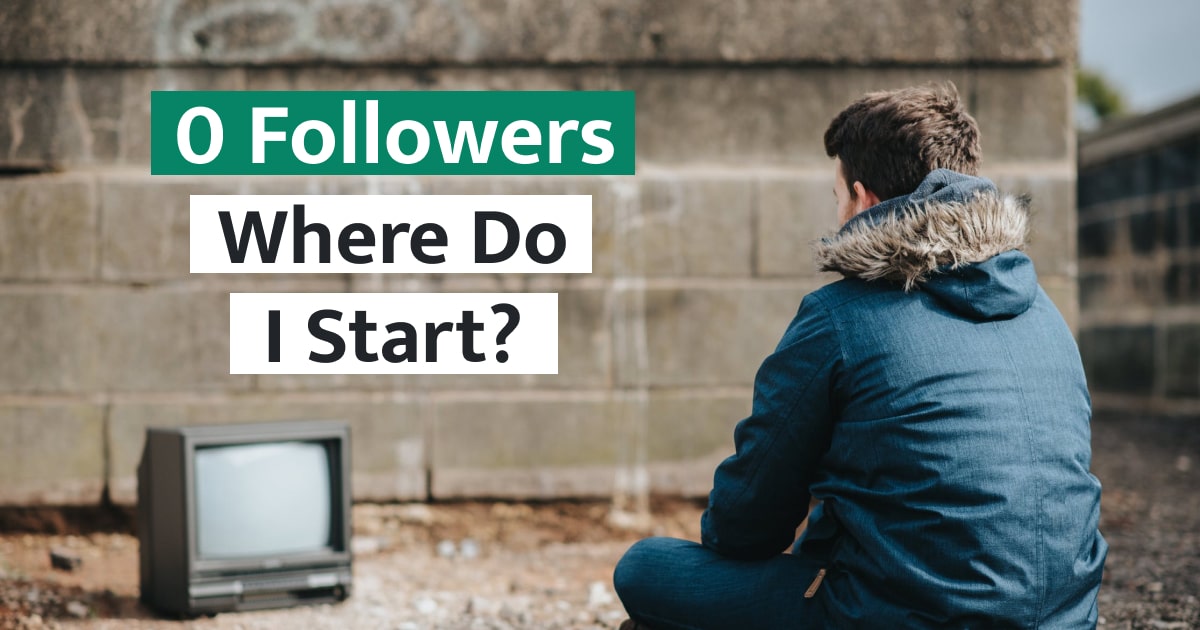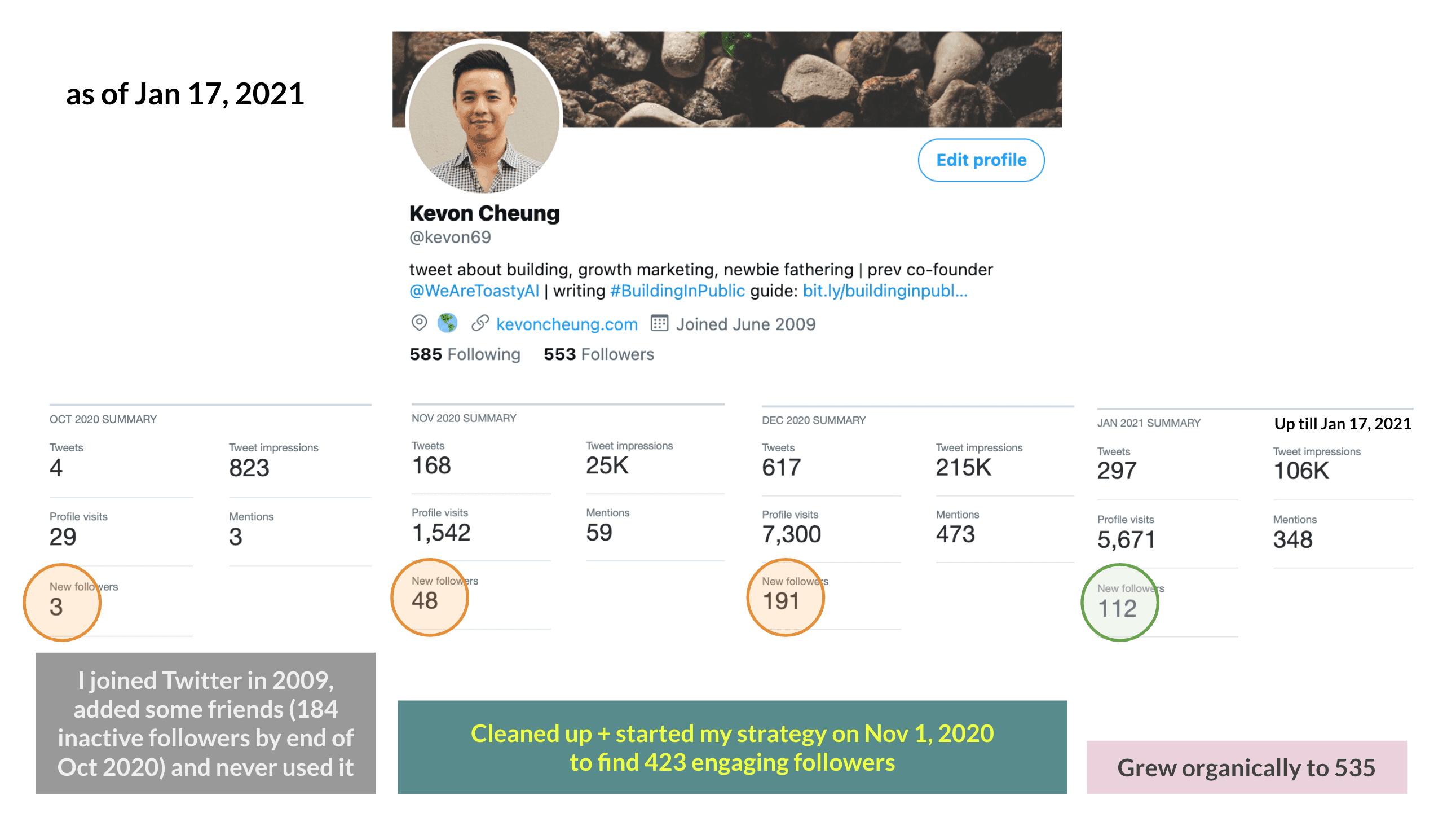How I grew my Twitter audience with human psychology

If you are new on Twitter and want to know how to grow to 500 followers with the right approach in 10 weeks, this article is for you.
I remember I was doing a sharing session on my Building in Public Definitive Guide and the host asked me, "Kevon, I see that you have a very cozy audience on Twitter. How did you start?"
"It was a lot of hard work! But mostly I think doing the right things helped the most." That's what I said.
And I could tell the participants really enjoyed the tips I shared, so this article is my way of helping more people get started.
As of Feb 2022, my presence has grown to 9,000+ followers. One year ago when I wrote this article, I had 553 followers after using Twitter for 10 weeks. which makes this sharing relevant to where you are now.

Once you have 500 followers, you can grow it organically.
Starting out
My Twitter account was created in 2009 but I barely used it in the last 11 years. I had about 100 people I was following but most of them were not active. I also had about 184 followers who were mainly friends.
My main goal was 1) to find the quickest way to get to 500 followers and 2) to be active in tweeting and engaging with a tight circle.
I knew that only when I achieved these two goals would people perceive me as a "real" person and want to interact with me.
With two clear goals, it was action time.
Finding out which circle I want to be in
Both online and offline, people always find similar, like-minded, friendly people to hang out with.
It meant that I could make the assumption that if Amanda is known for being a bootstrapped founder, her followers could also be interested in building bootstrapped businesses.
So I thought hard about what kind of people I wanted to interact with on Twitter.
I enjoyed solving problems and building products. I was also spending more and more time in the Indie Hackers community to share experiences and help other builders. Therefore, having deeper relationships with people in this community made a lot of sense.
I then came up with a list of 20 key influencers in this community. They were active in sharing ideas and all had a large following.
First, I followed all 20 of them.
Then I started engaging with their tweets. I looked at who was replying to their tweets and followed them as well. The action of replying to tweets shows how active this person is and how likely she is looking for people to engage with.
Therefore, I added three 45-minute blocks on my calendar in each week, and I'd spend all of the 45 mins on going to the top 20 influencers' accounts, engaging in the conversations, and following their active followers.
I wasn't following everyone I could find
When I looked at the people who replied to the influencer's tweets, they were coming from all walks of life. Following all of them would be a reckless strategy.
I was more interested in making friends who could help each other grow, so I wanted to know who would have the same objective as me and wanted to make new friends.
For people with e.g. 10k followers, they're likely overwhelmed by all their notifications and direct messages and so spend zero time finding out who follows them. They have a big audience, so their interest is in posting great content and engaging with their followers. It is highly unlikely they'd pay any attention to me if I follow them.
But for people with <600 followers, they're likely to be on the same stage as me, maybe a few steps ahead. They still want to grow, so they'd dedicate time to engage with anyone who just follows them. This means they'd care about me.
With this in mind, I only followed people who have <600 following and <600 followers. I knew it wouldn't matter eventually, but for now, I must stay focused on them.
I didn't mind making the first move
Creators new to growing an audience often make the mistake of focusing on their own too much. They care only about their tweets and numbers.
Now, imagine today is your first class at a university. You go into the classroom and have exactly zero friends, you can either pick a corner and sit with no one, or you can quickly scan the room to see who is smiling at you and sit near this student. The person who is smiling at you makes the first move in the relationship.
I knew the online world worked the same way, so I didn't want to wait for things to happen. I wanted to be the person who is making initiatives.
When one person makes the first move, the other person appreciates it.
So on top of following them, I also replied to their tweets and retweeted their tweets to give them exposure. I wanted to be a fun and helpful person who was not there to take advantage of people, I was there to give.
When I did this, I knew more people checked out my profile.
As down to earth as possible
So far I was doing a lot to grab attention from people, and I got them to visit my profile.
I had to grasp this opportunity to win a new follower. I needed to present the best, authentic version of myself in my profile.
I reminded myself of a few things:
I couldn't be too sales-sy because no one wants to befriend someone who is over the top. I wasn't there to sell anything, so I had to avoid putting any logo or tagline on my banner. It is social media, so images and words that represent my values and true self are the best.
I wanted to be human. I used a real picture (not an avatar), wrote simple words, and used emojis in my bio. I also added some personality like positioning myself as the "newbie dad".
I must focus on giving (not taking). And the most straightforward way to do that on Twitter is to retweet someone's tweet to help spread it or help people by answering questions.
I did all the above to increase the chance of people following me after they looked at my profile. It worked, many people followed me back after I followed them.
When they showed interest, I was ready to make friends
Once I got a new follower, I knew that was just an initial acknowledgment. There was more I needed to do if I wanted to turn these cold relationships into meaningful ones.
I asked questions, joked, and helped because we were, at this point, Twitter friends.
I didn't use direct messages just yet as I wanted to make sure I could get to know this person a little more. With both of us following each other, the likelihood of seeing each other's tweets was a lot higher, and I took that chance to engage more.
When interactions were going well, I then sent direct messages to take the relationship further. I didn't have any agenda in mind, but I was ready to learn about their lives, work, families, aspirations, and more.
I enjoyed getting on a video call to put a face on the name. But that was a "big ask" given most people were busy. I didn't force it and only arranged it when I felt right about the timing. "How do you know it's right?" When there is value exchanged on the call, not just a say-hi call.
Putting your heart into doing it
All of these are not just great for boosting your follower number to 500, but you're also building meaningful relationships that can go a long way.
I don't believe in any quick hacks to drive the growth of my audience because eventually, I know that these people don't care about what I do if they follow me for the wrong reasons.
I am more for the fundamentals of building and managing human relationships, I see that behind every large audience, there is always a strong core group of friends who are fuelling everything else we see.
I hope this is helpful to you. Try out some of the advice above first. If you want to go further, I also created a free 7-day email course, Making Twitter Friends, to deep dive into some of the concepts and so far 1,800+ students completed the course. Or if you want me to help you 1:1, you can also contact me.